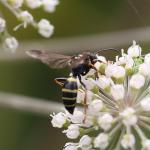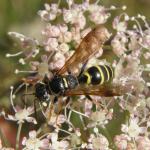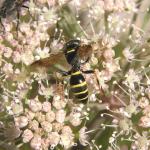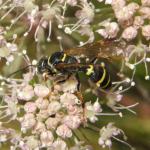Despite this being a widespread species, there is little published on its ecology and ethology.
Widely distributed across England, although absent from several counties. There is just one record from Wales (Caernarvonshire). Abroad, the species is found in most European countries from Scandinavia to the Mediterranean (Lomholdt, 1975-76). There are also records from the Eastern Palaearctic (Korea) (Bitsch et al., 1997).
This species is not regarded as being scarce or threatened.
Most often found in sandy places, sometimes on the coast or beside rivers.
Univoltine; early June to early September, most frequent in July.
Adults of Philaenus spumarius and possibly Neophilaenus spp. (Homoptera, Cercopidae).
The nest is usually dug in fairly sandy soil exposed to the sun, but can also be found in heavier soils. There is little reported in the literature on the nest structure of Gorytes quadrifasciatus but it is likely to be similar to other species in the genus. It is not known how many prey items are captured per cell; it is likely the egg is laid on the last prey brought in.
The adults are found taking nectar from such flowers as wild parsnip (Pastinaca sativa), hogweed (Heracleum sphondylium) and fennel (Foeniculum vulgare). Also, hawkweeds (Hieracium species) and angelica (Angelica species) (Lomholdt, 1975-76).
On the continent, G. quadrifasciatus is cleptoparasitized by several species of Nysson, including N. trimaculatus, which is reported to be parasitic in Britain (Richards, 1980). It is likely that sarcophagid flies are also cleptoparasites, or parasitoids.





